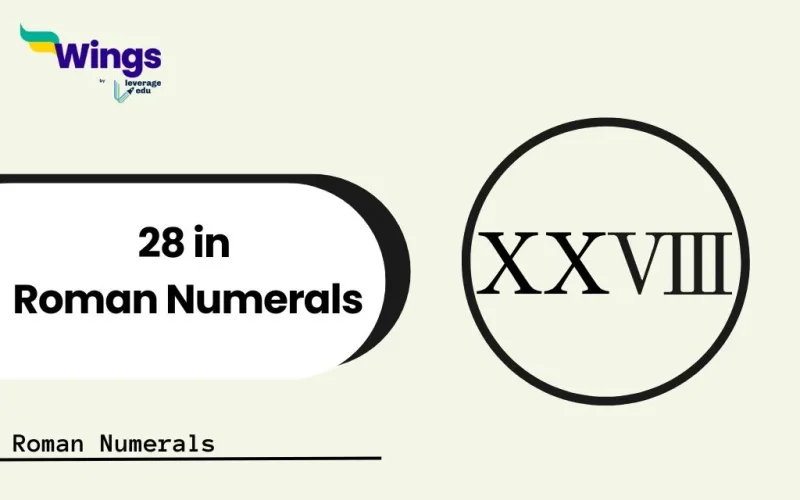Writing 28 in Roman numerals is easy once you understand the basic rules. Roman numerals use letters from the alphabet to represent numbers, each with a specific value. To write 28, we break it down into two parts: 20 and 8. In Roman numerals, 20 is written as XX (X for 10, repeated twice), and 8 is written as VIII (V for 5 and III for 3). When combined, 28 in Roman numerals is XXVIII. Learning Roman numerals is an enjoyable way to understand how ancient cultures represented numbers and counted.
Contents
How to Write 28 in Roman Numerals?
In Roman numerals, numbers are represented using letters from the Latin alphabet: I (1), V (5), X (10), L (50), C (100), D (500), and M (1000). These letters follow specific rules of addition and subtraction to represent numbers.
To write 28, we break it down into two parts: 20 and 8. The Roman numeral for 20 is XX (10 + 10), and the Roman numeral for 8 is VIII (5 + 3).
This follows the Principle of Addition in Roman Numerals. When we write 28 in Roman form, we place XX for 20 and VIII for 8. So, 28 in Roman numerals is XXVIII.
So, the Roman numeral for 28 is written as XXVIII.
| Number | Roman Numeral |
| 28 | XXVIII |
How to Convert XXVIII to Number
To convert XXVIII from Roman numerals to a number, you need to understand the values of the individual symbols.
- X represents 10
- V represents 5
- I represents 1
In XXVIII, the combination follows the principle of addition.
- XX represents 20 (since X is 10, and 10 + 10 equals 20).
- VIII represents 8 (V is 5, and III is 3, adding up to 8).
When combined, XXVIII equals 20 + 8, which totals 28.
Roman numerals are made up of seven symbols (I, V, X, L, C, D, M), and each has a fixed value. So, XXVIII represents 28.
| To convert XXVIII from Roman numerals to a number, follow these steps: Identify the values of the symbols: X = 10 X = 10 V = 5 I = 1 I = 1 I = 1 Add the values together: XX = 10 + 10 = 20 VIII = 5 + 1 + 1 + 1 = 8 Combine the two parts: 20 + 8 = 28 So, XXVIII equals 28. |
Here is the list of Roman Numbers from 21 to 30:
| 21 in Roman Number | 26 in Roman Number |
| 22 in Roman Number | 27 in Roman Number |
| 23 in Roman Number | 28 in Roman Number |
| 24 in Roman Number | 29 in Roman Number |
| 25 in Roman Number | 30 in Roman Number |
Exercise on 28 in Roman Numerals
Let us practice some questions on Roman Numerals here.
Addition and Subtraction
Add/subtract the following numbers and answer in Roman Numerals
- 86 + 28 = ___
- 100 – 28 = ___
- 82 + 28 = ___
- 82 – 28 = ___
Answers:
- CXIV
- LXXII
- CX
- LIV
Convert to Roman Numerals
Convert the following numbers into Roman numerals:
- 128
- 182
- 82
- 280
Answers:
- CXXVIII
- CXCII
- LXXXII
- CCLXXX
Convert to Numbers
Convert the following Roman numerals to numbers:
- XXIX
- XXVI
- XXIII
- XXVII
Answers:
1. XXIX
- XX = 20
- IX = 9
- 20 + 9 = 29
2. XXVI
- XX = 20
- VI = 6
- 20 + 6 = 26
3. XXIII
- XX = 20
- III = 3
- 20 + 3 = 23
4. XXVII
- XX = 20
- VII = 7
- 20 + 7 = 27
Match the Following
Match the following numbers to Roman numerals:
| Numbers | Roman Numerals |
| (i) 128 | (a) DCCCII |
| (ii) 182 | (b) CCVIII |
| (iii) 208 | (c ) CXCII |
| (iv) 802 | (d) CXXVIII |
Answers:
(i) 128 → (d) CXXVIII
(ii) 182 → (c) CXCII
(iii) 208 → (b) CCVIII
(iv) 802 → (a) DCCCII
Learn about other important Roman Numerals here:
Check out Roman Numerals here:
FAQs
28 in Roman numerals is written as XXVIII.
The rule involves breaking 28 into its components:
Write 20 as XX (two tens).
Write 8 as VIII (5 + 3).
Combine them to form XXVIII.
Ans: The Roman numerals for 28 are XXVIII because XX is 20 and VIII is 8. XXVII would be 27, so an additional I is needed to make 8.
27 = XXVII
28 = XXVIII
29 = XXIX
Roman numerals follow specific subtraction rules. Subtraction is only used for smaller numbers placed before larger ones (e.g., IV for 4). For 28, addition is used, hence XXVIII.
28 = XXVIII (20 + 8).
18 = XVIII (10 + 8).
The difference lies in the tens digit.
The Roman numeral for 280 is CCLXXX.
No. Roman numerals represent whole numbers only. 28 = XXVIII, while 2.8 cannot be expressed in Roman numerals.
For large numbers like 2800, Roman numerals use letters with overlines or brackets.
2800 = MMDCCC.
Roman numerals lack a zero and are cumbersome for large calculations, which makes systems like Arabic numerals more practical.
For more blogs on school education, follow Leverage Edu now.
 One app for all your study abroad needs
One app for all your study abroad needs














